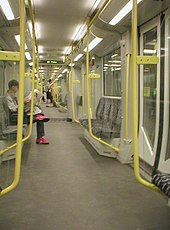BVG series HK
| U-Bahn Berlin small profile series HK |
|
|---|---|
| Number: | 24 multiple units |
| Manufacturer: | Prototypes (1001-1004): Adtranz ;
Series trains (1005-1024): Bombardier |
| Year of construction (s): | Prototypes: 1999, series: 2005–2006 |
| Axis formula : | Bo '(A1)' + (1A) 'Bo' + Bo '(A1)' + (1A) 'Bo' |
| Length over coupling: | 51,590 mm |
| Width: | 2300 mm |
| Trunnion Distance: | 7570 mm |
| Bogie axle base: | 1800 mm |
| Empty mass: | 70.0 t |
| Top speed: | 60 km / h |
| Hourly output : | 12 × 85 kW = 1020 kW |
| Power system : | 750 V = |
| Power transmission: | lateral busbar coated from above |
| Coupling type: | Scharfenberg coupling |
| Seats: | 76 (+ 12 folding seats) |
| Standing room: | 261 (12 folding seats as standing area) |
| Floor height: | 875 mm |
The small profile series HK is a vehicle type of the Berlin subway . Up to September 2015 it was the most modern vehicle type, this is currently the successor series IK . Structurally and technically, the trains largely correspond to the H series , but have been adapted to the small profile , which is what the “K” stands for in the type designation.
development
Originally, the cars in the HK series of small profiles were to be delivered around the same time as those of the H series of large profiles, which are very similar.
By 1997, 25 four-car trains were supposed to have been delivered. However, development was slow, so that not even a test train was available this year. The first delivery took place in 2001 and was initially limited to four four-car trains. Due to problems with the wheelsets, two units (1006 and 1007) delivered in summer 2006 could not be put into operation. Thereupon the delivery of the remaining trains was stopped. As early as April 2007, the small profile showed a considerable shortage of wagons due to the lack of HK trains and the retired A3L67 . After negotiations about compensation between BVG and Bombardier, the new trains were handed over to BVG via the transfer group at Wuhletal station between July 23, 2007 and the end of the year. The first trains delivered after the stop were 1008 and 1019, a week later the first series vehicles were used in regular traffic with the trains 1006 and 1007 that had already been delivered.
construction
The HK series has a lot in common with the H series. The train is also designed as an empty tube , but with a width that is 35 cm smaller. As far as possible, the technical devices are installed outside the passenger compartment. The end cars are 51 centimeters longer than the middle cars. A multiple unit consists of four cars, which often run as a double unit. This means that an enforcement (in contrast to the six-car trains of the H series) is not continuously accessible. Unlike the H series, the floor height is 875 mm.
Only three axles are driven per car (instead of four in the H type), the maximum speed is 60 km / h.
In contrast to the large profile type H, the front of the HK series is not rounded, but straight. Each trolley has three doors on each side with a clear width of 1300 mm. In contrast to the H series, there is not two, but only one window between the doors. The bellows between the cars are hardly drawn in, which on the one hand increases the volume of the passenger compartment and on the other hand increases the feeling of security.
The vehicles can only be coupled mechanically with the older types. With the successor series IK, on the other hand, the units can be coupled and controlled multiple times in order to allow greater flexibility when assembling trains.
commitment
The HK trains are mainly used on the U2 line , as eight -car trains are used here in the planned service. Since the 2015 timetable change, there have been occasional missions on the U1 line, as this line, which was previously only served with six cars, is now also served with eight cars. On the less frequented U3 , the trains are only used as dropouts from the U2, as there are usually only trains with six cars. Only two-car trains run on the U4 in regular traffic, so the HK trains are only used here for special trips such as the Christmas train.
See also
Web links
- Description of the HK series. 2007, archived from the original ; accessed on January 2, 2020 .
- Berlin traffic sites - type HK. Accessed January 2, 2020 .
Individual evidence
- ↑ Peter Neumann: BVG sends trains to the workshop due to defects . In: Berliner Zeitung . April 17, 2007.
- ↑ BVG puts 20 new underground trains into service . In: Berliner Morgenpost . July 21, 2007.
- ↑ Thomas Fülling: BVG puts 20 new underground trains into service for the U 2 line. In: The world . July 21, 2007, accessed January 2, 2020 .
- ↑ New underground trains go into operation - BVG press release. (No longer available online.) Berliner Verkehrsbetriebe , July 23, 2007, formerly in the original ; Retrieved July 23, 2007 . ( Page no longer available , search in web archives )
- ↑ IK17 - Icke for the large profile (technical drawing). www.bahninfo-forum.de , December 12, 2016, accessed on December 13, 2016 .


